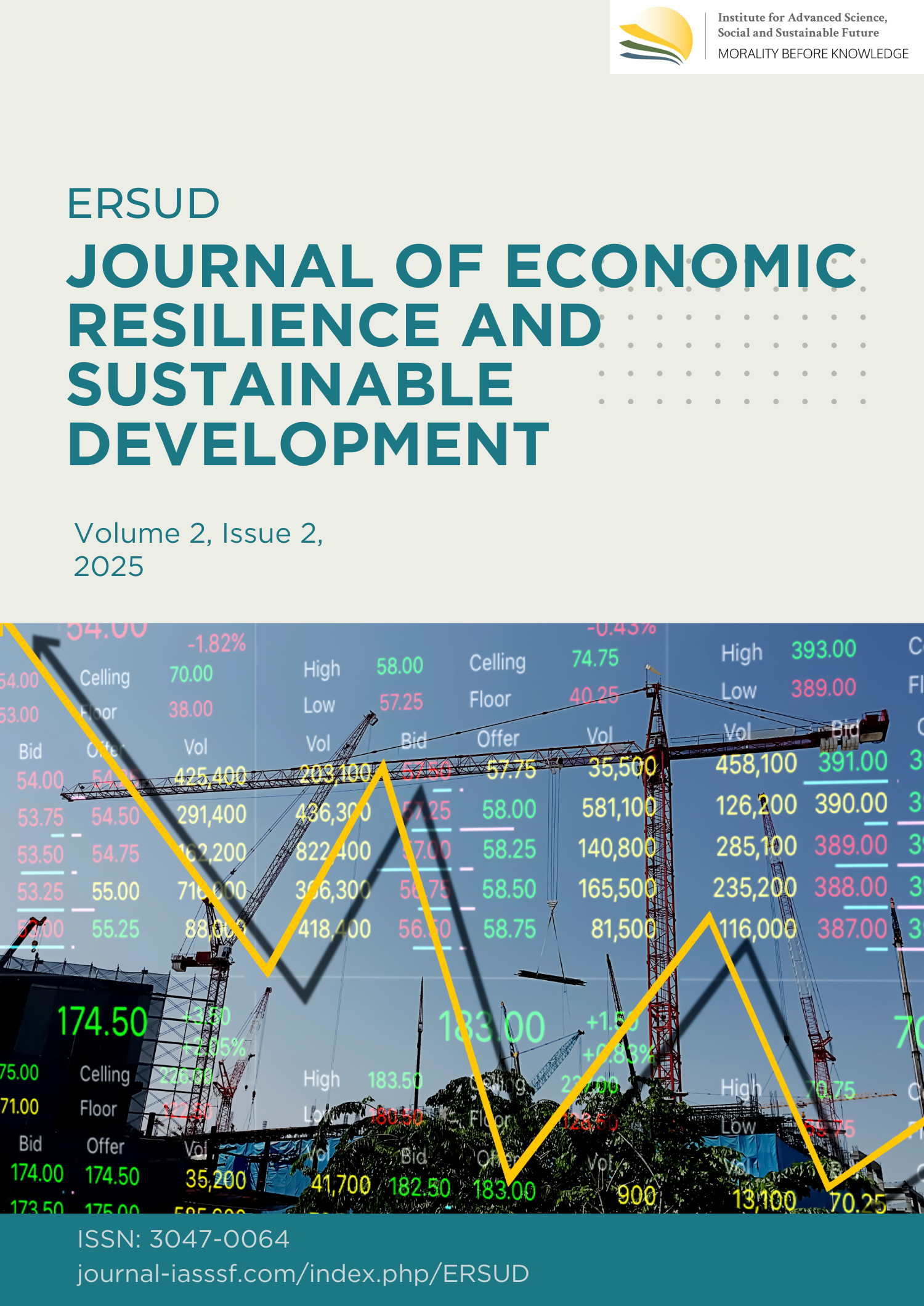Evaluation of the implementation of the village fund allocation policy
DOI:
https://doi.org/10.61511/ersud.v2i1.2025.1779Keywords:
evaluation, village fund allocation, public participation, autonomy, fiscal decentralizationAbstract
Background: The village fund allocation policy was introduced in Indonesia to enhance village financial capacity and autonomy. However, despite the implementation of Law No. 6/2014 on Villages, many villages, including Nguwok Village, still experience constraints in fully utilizing the village fund allocation funds due to regulatory control from the local government. This research aims to evaluate the implementation process of the village fund allocation in Nguwok Village, focusing on the allocation, utilization, and effectiveness of the funds within the framework of fiscal decentralization and village autonomy. Methods: This study employs a qualitative descriptive approach with purposive sampling to select key informants. Data collection methods include observations, document analysis, and in-depth interviews with stakeholders such as the Lamongan Regency Government, Modo Subdistrict Office, and Nguwok Village Administration. Findings: Out of seven effectiveness criteria, only three (range, frequency, and bias) were met, while access, service precision, program compatibility, and accountability remain ineffective. The village fund allocation implementation process is also found to be inefficient, with budgeting reports lacking transparency and not detailing fund expenditures. Conclusions: While the village fund allocation funds significantly contribute to Nguwok Village’s financial capacity, village autonomy remains constrained by local government regulations. Despite smooth intergovernmental coordination and timely fund disbursement, village-level decision-making power is limited, and public participation is insufficient. Additionally, budget transparency issues persist, with incomplete reporting of fund utilization. To fully realize village autonomy, the Nguwok Village government must take a more proactive role in decision-making rather than merely following district-level guidelines. Novelty/Originality of this Article: This study provides a critical evaluation of the limitations of the village fund allocation policy implementation despite the legal framework supporting fiscal decentralization. By highlighting the gap between policy and practice, this research offers practical recommendations for improving village autonomy, community participation, and financial transparency.
References
Aminullah, A., Gani, A. J. A., Suryadi, S., & Hariyono, B. S. (2022). Public policy implementation effectiveness (Case study of village fund implementation in Linggo Pasuruan). WACANA: Jurnal Sosial dan Humaniora, 25(2). https://wacana.ub.ac.id/index.php/wacana/article/view/845
Azwardi, A., & Sukanto, S. (2014). Efektifitas Alokasi Dana Desa (ADD) dan Kemiskinan di Provinsi Sumatera Selatan. Jurnal Ekonomi Pembangunan, 12(1), 29-41. https://doi.org/10.29259/jep.v12i1.4865
Budiono, B. S. (2013). Pelaksanaan Kebijakan Alokasi Dana Desa Berdasarkan Permendagri No. 37 Tahun 2007 Tentang Pedoman Pengelolaan Keuangan Desa (Studi di Desa Mergosari, Kecamatan Tarik, Kabupaten Sidoarjo). Universitas Brawijaya.
Djani, W., Therik, J. J., & Mbatu , E. M. (2022). Implementation of Village Fund Utilization Policy in Supporting Autonomy of Oefafi Village in East Kupang District, Kupang Regency - East Nusa Tenggara Province. The Es Accounting And Finance, 1(01), 26–33. https://esj.eastasouth-institute.com/index.php/esaf/article/view/24
Ginting, A. H., Widianingsih, I., Mulyawan, R., & Nurasa, H. (2023). Village government’s risk management and village fund administration in Indonesia. Sustainability, 15(24), 16706. https://doi.org/10.3390/su152416706
Gocer, O., Boyacioglu, D., Ergoz Karahan, E., & Shrestha, P. (2024). Cultural tourism and rural community resilience: A framework and its application. Journal of Rural Studies, 107, 103238. https://doi.org/10.1016/j.jrurstud.2024.103238
Herianti, E., & Litdia, L. (2021). The Role of Village Fund Allocation (ADD) in Improving Community Welfare Through Village Potential. Jurnal Tata Kelola Dan Akuntabilitas Keuangan Negara, 8(1), 99–115. https://doi.org/10.28986/jtaken.v8i1.752
Kusmayadi, D. (2022). Implementation of village fund allocation utilization program in improving community empowerment (Case study in Baribis Village of Cigasong District of Majalengka Regency, Indonesia). Budapest International Research and Critics Institute-Journal (BIRCI-Journal), 5(2). https://doi.org/10.33258/birci.v5i2.5118
Iswari, H. R., & Indriani, T. (2024). Opportunities and challenges for developing thematic villages for the independence of Malang City. Pangripta: Jurnal Ilmiah Kajian Perencanaan Pembangunan, 7(1). Retrieved from https://jurnalpangriptav3.malangkota.go.id/PANGRIPTA/article/view/38
Mardiyanta, A. (2013). State of the art: Konsep partisipasi dalam ilmu administrasi publik. Jurnal Masyarakat, Kebudayaan dan Politik, 26(4), 227-242. https://e-journal.unair.ac.id/MKP
Mubarokah, L., Ningrum, I. K. ., & Hidayah, S. N. (2021). Assistance in Increasing Community Livelihoods through Optimizing the Business Role of Village Owned Enterprises. SERUNAI, 1(1), 22–38. https://jurnal.idfos.or.id/index.php/serunai/article/view/26
Moleong, L. J. (2010). Metodologi Penelitian Kualitatif. Pustaka Pelajar.
Noor, I. (2012). Politik otonomi daerah untuk penguatan NKRI. Seven Strategic Studies,
Nugroho, R. (2003). Kebijakan publik formulasi, implementasi dan evaluasi. Elex Media Komputindo.
Patton, M. Q. (2006). Metode evaluasi kualitatif. Yogyakarta Pustaka Pelajar.
Pitoi, L., Aneta, A., & Tohopi, R. (2024). Implementation of the village fund allocation (ADD) policy in Lamu Village, Tilamuta District Boalemo District. PubBis: Jurnal Pemikiran dan Penelitian Administrasi Publik dan Administrasi Bisnis, 8(1), 1–11. https://doi.org/10.35722/jurnalpubbis.v8i1.754
Pranarka, A. M. W. & Moeljarto, V. (1996). Pemberdayaan (Empowerment). In Prijono, Onny S. dan Pranarka, A,M.W (Eds.), Pemberdayaan: Konsep, Kebijakan danImplementasi (hlm. 44-70). Centre for Strategic and International Studies (CSIS).
Prastowo, A. (2011). Metode Penelitian Kualitatif. Ar-Ruzz Media. Sagala,
Sahdan, G. (2004). Buku Saku Pedoman Alokasi Dana Desa. FPPD.
Sugiyono. (2008). Metode Penelitian Kuantitatif, Kualintatif, dan R & D. CV. Alfabeta, Bandung
Sumarto, H. (2004). Inovasi, Partisipasi dan Good Governance. Yayasan Obor Indonesia.
Supriyanto, S., & Damayanti, N. A. (2007). Buku Perencanaan dan Evaluasi. Airlangga University Press.
Syaiful. (2000). Administrasi Pendidikan Kontemporer. CV Alfabeta.
Thomas. (2013). Pengelolaan Alokasi Dana Desa Dalam upaya Meningkatkan Pembangunan di Desa Sebawang Kecamatan Sasayap Kabupaten Tanah Tidung.
Wahyuni, R. (2011). Implementasi dan Evaluasi Kebijakan Publik. Surabaya. PT. Revka Petra Media.
Wasistiono, S. (2006). Prospek pengembangan desa. Fokusmedia.
Widjaja, H.A.W. (2003). Otonomi Desa : Merupakan Otonomi yang Asli, Bulat dan Utuh. PT. Raja Grafindon Persada. Jakarta
Winarno, B. (2007). Kebijakan Publik: Teori dan Proses. PT. Buku Kita.
Downloads
Published
Issue
Section
Citation Check
License
Copyright (c) 2025 Alif Hazmi Istifazhuddin, Antun Mardiyanta

This work is licensed under a Creative Commons Attribution 4.0 International License.















